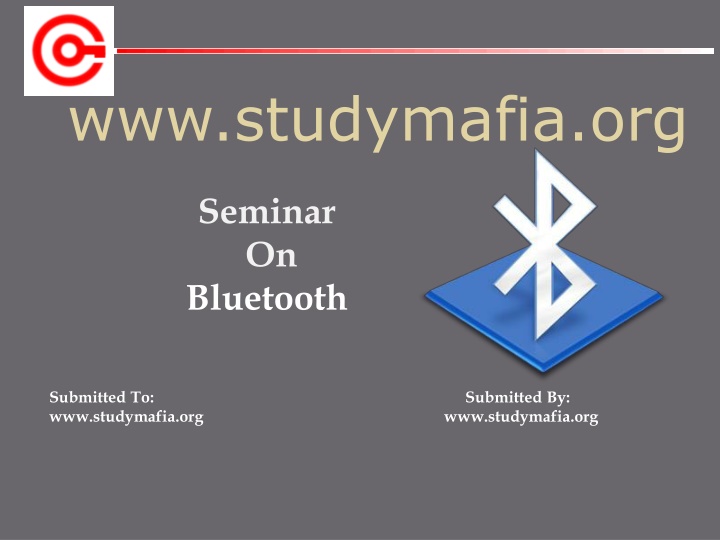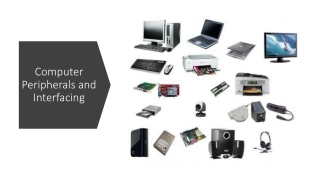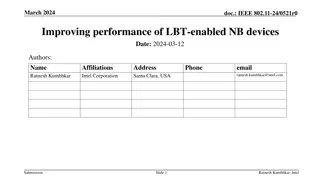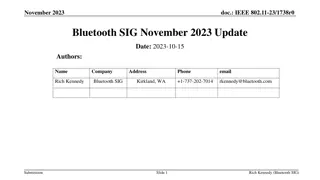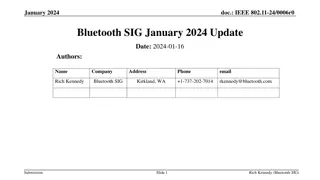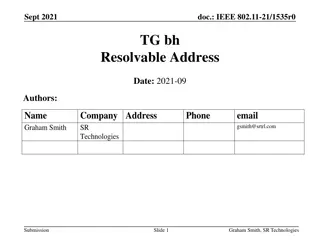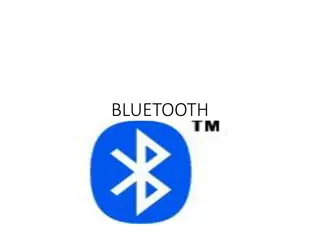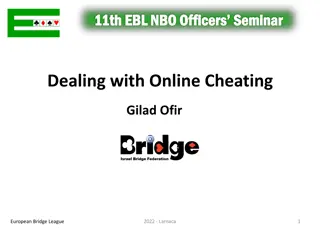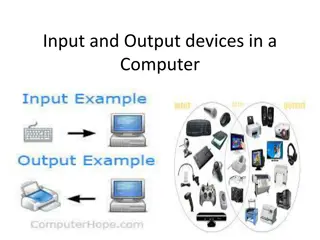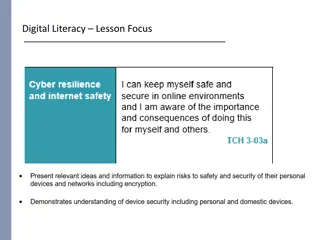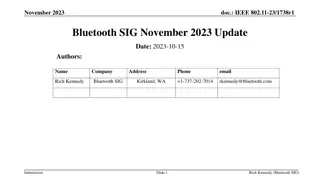Seminar on Bluetooth: History, Devices, Advantages, and Future
Bluetooth technology revolutionized wireless connectivity, enabling device communication without cords or adapters. Learn about the history of Bluetooth, its types of devices, importance, advantages, disadvantages, applications, characteristics, and future prospects. Explore how Bluetooth works, its development by Ericsson, and the technology behind it. Discover the different types of Bluetooth devices and their functions in various settings. Stay informed about the latest advancements and possibilities in Bluetooth technology.
Download Presentation

Please find below an Image/Link to download the presentation.
The content on the website is provided AS IS for your information and personal use only. It may not be sold, licensed, or shared on other websites without obtaining consent from the author.If you encounter any issues during the download, it is possible that the publisher has removed the file from their server.
You are allowed to download the files provided on this website for personal or commercial use, subject to the condition that they are used lawfully. All files are the property of their respective owners.
The content on the website is provided AS IS for your information and personal use only. It may not be sold, licensed, or shared on other websites without obtaining consent from the author.
E N D
Presentation Transcript
www.studymafia.org Seminar On Bluetooth Submitted To: www.studymafia.org www.studymafia.org Submitted By:
Introduction What is Bluetooth History Types Of Bluetooth Devices: Importance Of Bluetooth Advantages Disadvantages Application Characteristics Of Bluetooth Future Of Bluetooth Conclusion Reference
This technology provides short-range, wireless connectivity between devices. It is intended to replace the cables connecting portable and/or fixed electronic devices. Cables limit the mobility of the consumer and are easily lost or broken.
Bluetooth is a wireless technology used to transfer data between different electronic devices. The distance of data transmission is small in comparison to other modes of wireless communication. This technology eradicates the use of cords, cables, adapters and permits the electronic devices to communicate wirelessly among each other. Bluetooth is a high-speed, low-power microwave wireless link technology, designed to connect phones, laptops, PDAs and other portable equipment together with little or no work by the user. (or)
Bluetooth was invented in 1994 by Ericsson. The company later started working with a larger group of companies called the Bluetooth Special Interests Group, or "SIG," to develop the technology into what it is today. Bluetooth is not owned by any one company and is developed and maintained by SIG. The name Bluetooth came from a code name originally used by SIG for the project and is a reference to a 10th century Danish king named Harold Bluetooth, who was responsible for uniting Norway, Sweden, and Denmark.
What is Bluetooth Technology: It comprises of a base band processor, a radio and an antenna . The base-band processor converts the data into signals, the antenna of another blue tooth device, within at least 30 feet distance, receives a transmitted signal in the air. It uses a frequency hopping spread spectrum technique (FHSS) - which is one of two basic modulation techniques used in spread spectrum signal transmission. Frequencies are switched repeatedly during radio transmission to help reduce unlawful access or other means of telecommunications to cross paths and cause interruption
Types Of Bluetooth Devices: 1. Head Set 2. In-Car Bluetooth System 3. Bluetooth Equipped Printer 4. Bluetooth Equipped Web Cam 5. Bluetooth GPS System 6. Bluetooth Key Board
These have Replaced cables for transferring Information from one Electronic Device to another one. These have decreased Strain like carrying phones while talking, making hands free to do another work. This is cheaply Available. It s Mobility is also very Important as it doesn t need any power outlet or Internet connection or any other items.
Eliminates wires Facilitates Data and Voice Communication Offers formation of Ad hoc networks Standardized protocol Free of charge Easy to use Low power consumes battery less Stationary and mobile environments
Disadvantages Of Bluetooth: Data sent between two Bluetooth devices is very slow compared with Wi-Fi transfer Rate. Range Of a Bluetooth Device is 15-30 feet depending upon the Device. Security is Biggest Disadvantage as transfer takes place through radio waves and a hacker can easily hack it. Battery usage is also a problem, it will make device out of power before it would have if Bluetooth was not powered on.
The Internet Bridge An extension of this model could be a mobile computer that allows surfing the Internet irrespective of the location of the user, and regardless of whether the user is cordlessly connected through a mobile phone (cellular) or through a wire line connection (e.g. PSTN, ISDN, LAN, xDSL). Automatic Check-in Hotels are testing, or plan to test, services that allow guests to check in, unlock room doors and even control room temperature with handheld devices equipped with Bluetooth Technology
It separates the frequency band into hops. This spread spectrum is used to hop from one channel to another, which adds a strong layer of security. Up to eight devices can be networked in a piconet. Signals can be transmitted through walls and briefcases, thus eliminating the need for line-of- sight. Devices do not need to be pointed at each other, as signals are omni-directional. Governments worldwide regulate it, so it is possible to utilize the same standard wherever one travels
Bluetooth has a good future ahead because it meets a basic need of connectivity. Currently a protocol is being researched that would support large ad hoc networks. Latest version of Bluetooth are improving both its security and capabilities. Ultra wide band has been chosen by the Bluetooth Special Interest Group as the future of Bluetooth Technology. New versions of Bluetooth technology will meet the high-speed and large range. Many companies are designing impressive bluetooth applications in demand.
Authentication and encryption is provided at the Link Manager layer. The PIN is translated into a 128 bit link key which is used for authentication. After authentication the radios will settle on a suitable length encryption key to be used. Bluetooth relies on PIN codes to establish trusted relationships between devices.
A new global standard for data and voice Eliminates Cables. Low Power, Low range, Low Cost network devices. Bluetooth seems to have a bright future after reviewing its benefits and wide use. Further improvements are planned to be made in Data Rates Power Reduction Range
www.google.com www.wikipedia.com www.studymafia.org
